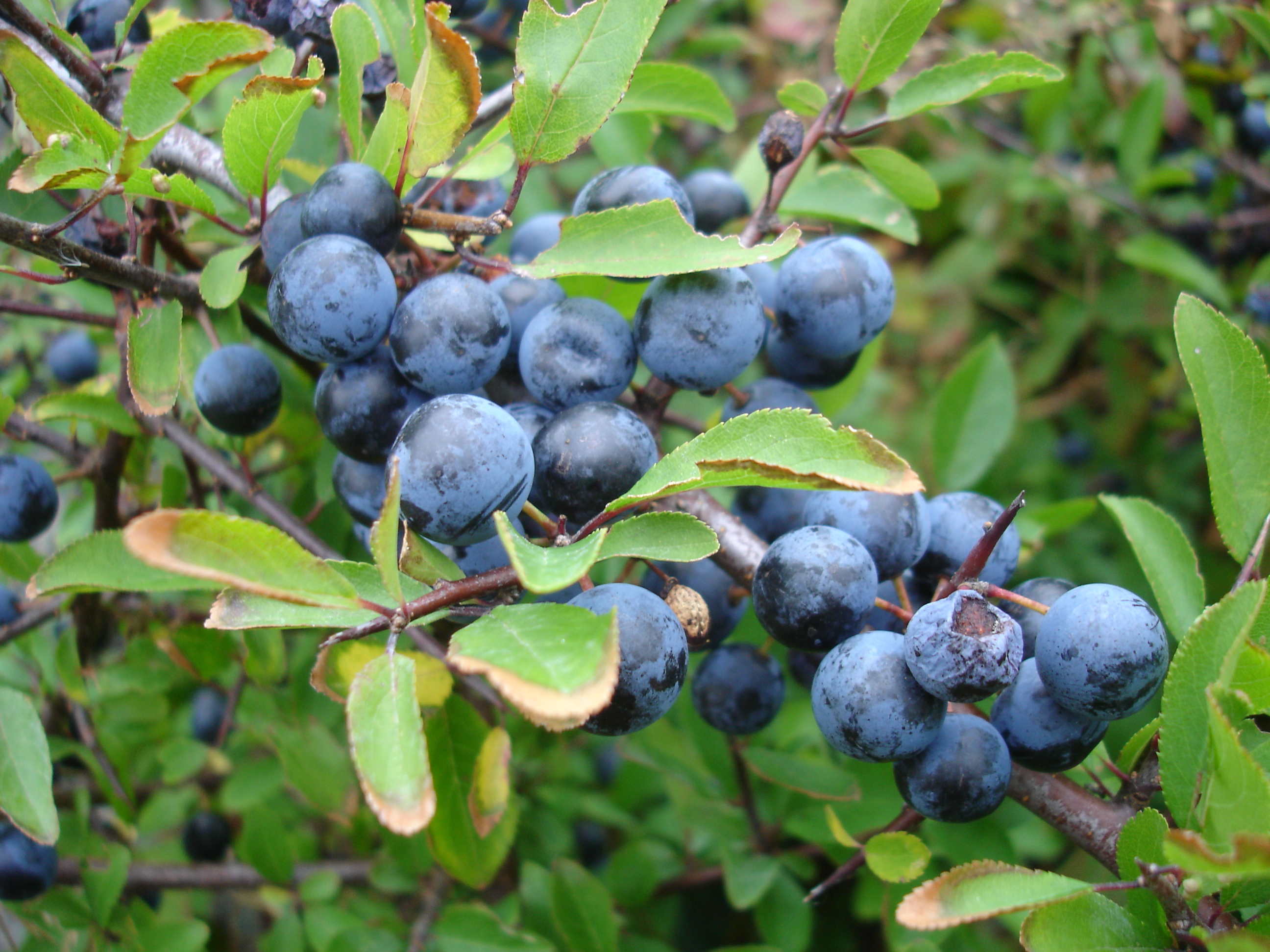- Prunus spinosa
:"Blackthorn redirects here; for other uses, see
Blackthorn (disambiguation) "Taxobox
name = "Prunus spinosa"

image_width = 240px
image_caption = Fruit
regnum =Plant ae
divisio = Magnoliophyta
classis =Magnoliopsida
ordo =Rosales
familia =Rosaceae
subfamilia =Prunoideae
genus = "Prunus "
subgenus = "Prunus"
sectio = "Prunus"
species = "P. spinosa"
binomial = "Prunus spinosa"
binomial_authority = L."Prunus spinosa" (Blackthorn or Sloe) is a species of "
Prunus " native toEurope , westernAsia , and locally in northwestAfrica .Rushforth, K. (1999). "Trees of Britain and Europe". Collins ISBN 0-00-220013-9.] Den Virtuella Floran: [http://linnaeus.nrm.se/flora/di/rosa/prunu/prunspiv.jpg"Prunus spinosa" map] ]It is a
deciduous largeshrub or smalltree growing to 5 m tall, with blackish bark and dense, stiff, spiny branches. The leaves are oval, 2–4.5 cm long and 1.2–2 cm broad, with a serrated margin. Theflower s are 1.5 cm diameter, with five slightly creamy-white petals; they are produced shortly before the leaves in early spring, and are hermaphroditic andinsect -pollinated. Thefruit , called a "sloe" is adrupe 10–12 mm diameter, black with a pale purple-blue waxy bloom, ripening in autumn, and harvested in October or November - usually after the first frosts. They are thin-fleshed, with a very stronglyastringent flavour when fresh.It is frequently confused with the related
cherry plum ("Prunus cerasifera"), particularly in early spring when the latter starts flowering somewhat earlier than "P. spinosa". They can be distinguished by flower colour, creamy white in "P. spinosa", pure white in "P. cerasifera". They can also be distinguished in winter by the more shrubby habit with stiffer, wider-angled branches of "P. spinosa", and in summer by the relatively narrower leaves of "P. spinosa", more than twice as long as broad.Vedel, H., & Lange, J. (1960). "Trees and Bushes in Wood and Hedgerow". Metheun & Co. Ltd., London.]Ecology
The foliage is sometimes eaten by the
larva e ofLepidoptera including Emperor Moth,Common Emerald ,November Moth ,Pale November Moth ,Mottled Pug ,Green Pug ,Brimstone Moth ,Feathered Thorn ,Brown-tail ,Yellow-tail ,Short-cloaked Moth ,Lesser Yellow Underwing ,Lesser Broad-bordered Yellow Underwing ,Double Square-spot and the Black andBrown Hairstreak s.Cultivation and uses
The fruit is similar to a small
damson orplum , suitable for preserves, but rather tart and astringent for eating, unless deeply frozen, as is practised ineastern Europe . In rural Britain so-calledsloe gin is made from them, though this is not a truegin but an infusion of vodka, gin, or neutral spirits with the fruit to produce aliqueur . InNavarre ,Spain , a popular liqueur called "patxaran " is made with sloes. Sloes can also be made into jam and, if preserved invinegar , are similar in taste to Japaneseumeboshi .It is extensively planted for hedging and for cover for game birds. The small thorns of the plant are relatively common causes of minor wounds in livestock, and these wounds often fester until the thorn is expelled or removed.Straight blackthorn stems have traditionally been made into a
walking stick or club (known inIreland as a shillelagh).The species is locally naturalised in
New Zealand and easternNorth America .A "sloe-thorn worm" used as fishing bait is mentioned in the 15th century work, "The Treatyse of Fishing with an Angle", by
Juliana Berners . [ [http://www.farreaches.org/compendium/treatise/onetreatise.html "The Treatyse of Fishing with an Angle"] (attributed to DameJuliana Berners in the15th century )]The expression "sloe-eyed" for a person with dark eyes comes from the fruit, and is first attested in A.J.Wilson's 1867 novel "Vashti". ["Oxford English Dictionary"]
References
Wikimedia Foundation. 2010.
